Key Takeaways
- Ring-necked snakes are easily recognized by their colorful neck ring and smooth scales.
- They are mostly nocturnal and prefer hiding under rocks or logs during the day.
- These snakes primarily eat small creatures like earthworms and salamanders.
- Mating occurs in spring, and females lay eggs in summer, with hatchlings being independent from birth.
- Despite their striking appearance, ring-necked snakes are harmless and pose no threat to humans or pets.
Identification and Physical Characteristics
Distinctive Coloration and Markings
The ring-necked snake is easily recognized by its unique color patterns. Its back can be olive, brown, or nearly black, while the belly is often a bright yellow, orange, or red. A key feature is the distinct neck band that can be yellow, red, or orange, which sets it apart from other snakes. Some populations may lack this band, but most individuals will have it.
Size and Scale Patterns
Adult ring-necked snakes typically measure between 10 to 15 inches (25 to 38 cm) in length. The largest recorded size is about 20.5 inches (52 cm). Their scales are smooth, and they usually have 15 to 17 scale rows at midbody.
| Size Category |
Length (inches) |
Length (cm) |
| Hatchlings |
3-4 |
8-10 |
| Adults |
10-15 |
25-38 |
| Maximum Size |
20.5 |
52 |
Comparison with Similar Species
While the ring-necked snake is distinctive, it can be confused with the flat-headed snake. Here are some differences:
-
Neck Band: Ring-necked snakes have a neck band; flat-headed snakes do not.
-
Color: Ring-necked snakes are darker, while flat-headed snakes are lighter.
-
Belly Color: The belly of a flat-headed snake is pink without spots, unlike the spotted belly of the ring-necked snake.
The ring-necked snake's small size and vibrant colors make it a fascinating species to observe in the wild.
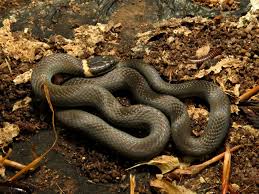
Habitat and Distribution
Geographical Range
Ring-necked snakes are found across a wide area, from southeastern Canada to central Mexico. They inhabit various regions in the United States, including:
- Eastern Seaboard from the Gulf of Saint Lawrence to Texas
- Northern Minnesota and Iowa
- Spotty populations in the Pacific Northwest
Preferred Environments
These snakes prefer habitats that offer plenty of cover and places to hide. Common environments include:
- Open woodlands near rocky hillsides
- Wet areas with abundant vegetation
- Urban areas where they can find refuge from predators
Adaptations to Different Habitats
Ring-necked snakes have adapted well to different environments. They can be found in:
- Moist habitats with rich soil
- Areas with plenty of hiding spots like logs and rocks
- Urban settings, where they can escape from threats
Ring-necked snakes thrive in various habitats, showing their ability to adapt to both natural and urban environments. Their flexibility in habitat choice helps them survive in changing landscapes.
Behavior and Lifestyle

Nocturnal and Crepuscular Activities
The black snake with a red ring around its neck is primarily nocturnal, meaning it is most active during the night. It often hunts during twilight hours, which is when it can find food while avoiding many predators. This behavior helps it thrive in various environments.
Social Structure and Colonies
These snakes are generally solitary creatures, but they can sometimes be found in small groups. They may gather in communal dens during colder months. Here are some key points about their social behavior:
-
Solitary Nature: Most of the time, they prefer to be alone.
-
Communal Dens: They share dens with others during hibernation.
-
Territorial Behavior: They can be territorial, especially males during mating season.
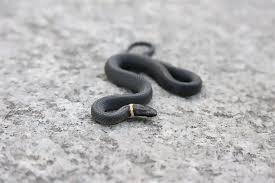
Defensive Mechanisms
When threatened, the black snake with a red ring has several ways to protect itself:
-
Camouflage: Its coloration helps it blend into the environment.
-
Feigning Death: It may play dead to avoid being eaten.
-
Biting: If cornered, it can bite, but it is generally non-venomous.
The black snake with a red ring is often mistaken for more dangerous species, like the coral snake. This is especially true for snakes such as coral snakes and kingsnakes, with the non-venomous kingsnake mimicking the extremely venomous coral snake. Learning to identify them can help in avoiding unnecessary fear.
Diet and Feeding Habits

Primary Prey Items
Unleash your bold style with the Serpentine Alloy Snake-shaped Punk Ring! This unisex statement piece, available in three striking colors, wraps around your finger with fierce elegance. Perfect for those who dare to stand out, this ring adds a touch of edgy charm to any outfit. Grab yours now and embrace the wild side of fashion!
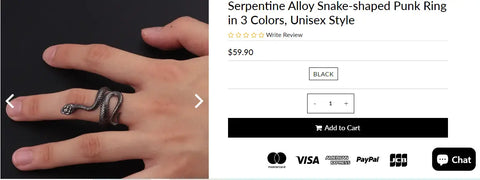
The ring-necked snake primarily feeds on a variety of small creatures. Its diet includes:
-
Amphibians: such as salamanders and frogs
-
Invertebrates: including earthworms and slugs
-
Small mammals: occasionally, it may consume small rodents
Hunting and Feeding Techniques
These snakes are nocturnal hunters, using a combination of techniques to capture their prey:
-
Striking: They quickly strike at their prey.
-
Constriction: Larger prey are immobilized using a mild venom.
-
Swallowing: Smaller prey are often swallowed alive.
Role of Venom in Prey Capture
While ring-necked snakes are not highly venomous, they possess a specialized structure called the Duvernoy's gland. This gland helps them deliver venom through their rear fangs, which aids in subduing prey. The venom affects the prey's ability to escape, making it easier for the snake to consume it.
Ring-necked snakes are often mistaken for garden snakes due to their non-aggressive nature and small size. They play an important role in controlling pest populations in their habitats.
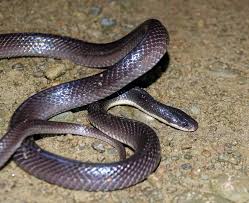
Reproduction and Life Cycle
Mating Behavior
Ring-necked snakes typically mate in the spring. In some subspecies, mating can also happen in the fall, with a process called delayed implantation. Females attract males by releasing special scents from their skin. Once a male finds a female, he moves his mouth along her body and bites her around the neck ring to align their bodies for mating.
Egg Laying and Hatching
Females lay their eggs in loose, airy soil, often under rocks or in decaying logs. The number of eggs can range from three to ten, and they are usually laid in early summer. The eggs are elongated and white, with yellow ends. They typically hatch in late summer or early fall, around August or September.
Juvenile Development
When they hatch, the young snakes are already able to take care of themselves. They do not receive any parental care and must fend for themselves right away. This independence is crucial for their survival in the wild.
Ring-necked snakes are fascinating creatures with unique reproductive habits that help them thrive in various environments.
| Stage of Life |
Description |
| Mating Season |
Spring (or fall for some subspecies) |
| Egg Laying |
3-10 eggs in early summer |
| Hatching Period |
August to September |
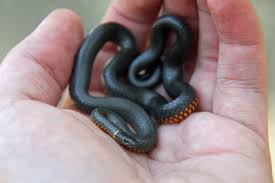
Subspecies and Variations
Recognized Subspecies
The ring-necked snake has 14 recognized subspecies. Each subspecies has unique traits and adaptations. Here’s a list of some notable ones:
-
D. p. acricus - Key ring-necked snake
-
D. p. amabilis - Pacific ring-necked snake
-
D. p. anthonyi - Todos Santos Island ring-necked snake
-
D. p. arnyi - Prairie ring-necked snake
-
D. p. dugesii - Dugès' ring-necked snake
Morphological Differences
Different subspecies can vary in:
-
Coloration - Some may have brighter or darker colors.
-
Size - Certain subspecies are larger than others.
-
Scale Patterns - The arrangement of scales can differ.
Geographical Variations
The geographical range of these subspecies includes:
-
North America - Found widely across the U.S.
-
Central Mexico - Some subspecies are native here.
-
Canada - Certain types reach as far north as Quebec.
Understanding these variations helps in identifying the specific type of ring-necked snake you might encounter. Each subspecies plays a role in its ecosystem, contributing to biodiversity.
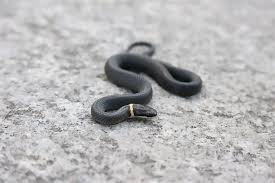
Safety and Human Interaction
Non-Venomous Nature
The black snake with a red ring around its neck is non-venomous, making it safe for humans. These snakes are often mistaken for more dangerous species, but they pose no threat. Their primary defense is to hide or flee rather than attack.
Safety Around Humans and Pets
When encountering these snakes:
- Stay calm and observe from a distance.
- Do not attempt to handle them; they are not aggressive.
- Keep pets away to avoid any stress to the snake.
Conservation Status and Threats
The conservation status of these snakes is generally stable, but they face threats from habitat loss and pollution. Here’s a quick overview:
| Threat Type |
Description |
| Habitat Loss |
Urban development reduces their space. |
| Pollution |
Chemicals can harm their environment. |
| Climate Change |
Alters their natural habitats. |
Understanding the non-venomous nature of these snakes can help reduce fear and promote coexistence. They play an important role in the ecosystem by controlling pest populations.
Conclusion
In summary, the ring-necked snake is a fascinating creature that showcases unique behaviors and adaptations. Its bright colors serve as a warning to potential predators, helping it survive in the wild. These snakes are mostly active at night and prefer to hide during the day. They play an important role in their ecosystems by controlling populations of small animals. Understanding and appreciating these snakes can help us protect them and their habitats. Overall, the ring-necked snake is a remarkable example of nature's creativity and resilience.
Frequently Asked Questions
What does a ring-necked snake look like?
A ring-necked snake is small, usually about 10 to 14 inches long. It has a dark body, often gray or black, and a bright ring around its neck that can be orange or red. Its belly is usually a bright color like yellow or orange with black spots.
Where can you find ring-necked snakes?
These snakes are found all over the United States, from Canada down to Mexico. They like to live in places like meadows, forests, and even suburban areas.
What do ring-necked snakes eat?
Ring-necked snakes mainly eat small creatures like earthworms, slugs, and sometimes small lizards and frogs. They are good at hunting at night.
Are ring-necked snakes dangerous to humans?
No, ring-necked snakes are not dangerous. They are non-venomous and harmless to people and pets.
How do ring-necked snakes protect themselves?
When scared, these snakes curl their tail and show their brightly colored belly, which can startle predators. They may also release a smelly musk to deter threats.
How do ring-necked snakes reproduce?
Ring-necked snakes usually mate in spring. Females lay eggs in loose soil, and the eggs hatch in late summer. Baby snakes are independent right after they hatch.
Unleash your bold style with the Serpentine Alloy Snake-shaped Punk Ring! This unisex statement piece, available in three striking colors, wraps around your finger with fierce elegance. Perfect for those who dare to stand out, this ring adds a touch of edgy charm to any outfit. Grab yours now and embrace the wild side of fashion!

Dive into the fascinating world of snakes and explore our other articles now!
Stay Updated!
Don't miss out on the latest insights, tips, and exclusive content. Subscribe to our blog newsletter today and be the first to know about new posts, special offers, and more!
Join our community now—just enter your email below to stay connected